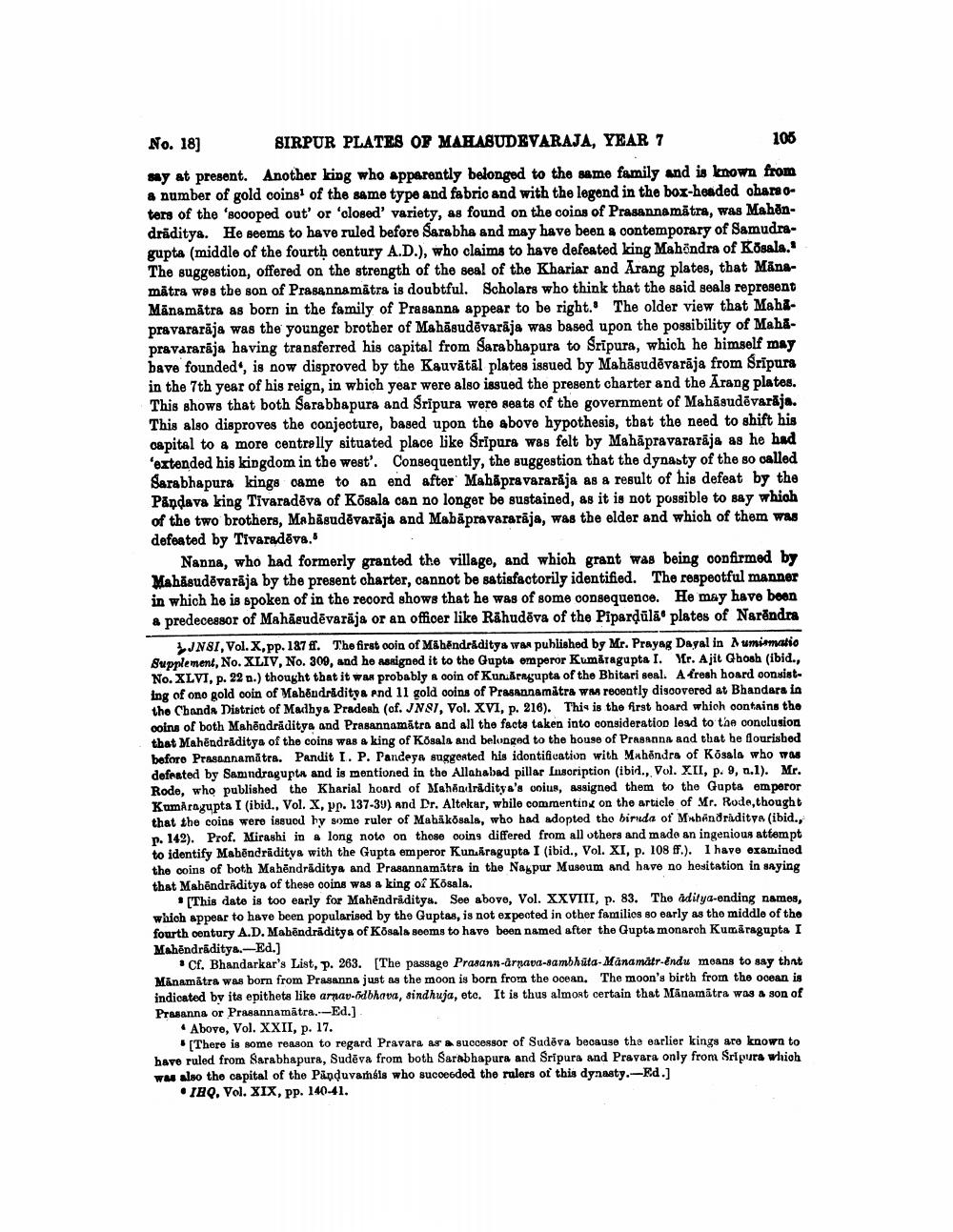________________
No. 18) SIRPUR PLATES OF MAHASUDEVARAJA, YEAR 7
106 say at present. Another king who apparently belonged to the same family and is known from a number of gold coins of the same type and fabric and with the legend in the box-headed obara 0ters of the 'scooped out' or 'closed' variety, as found on the coins of Prasannamätra, was Mahondraditya. He seems to have ruled before Sarabhs and may have been a contemporary of Samudragupta (middle of the fourth century A.D.), who claims to have defeated king Mahindra of Kosala." The suggestion, offered on the strength of the seal of the Khariar and Arang plates, that Manamatra was the son of Prasannamatra is doubtful. Scholars who think that the said seals represent Mänamātra as born in the family of Prasanna appear to be right. The older view that Mahipravararaja was the younger brother of Mahāsudēvarāja was based upon the possibility of Mahapravararaja having transferred his capital from Sarabhapura to Sripura, which he himself may bave founded', is now disproved by the Kauvātāl plates issued by Mahasudevarāja from Sripura in the 7th year of his reign, in which year were also issued the present charter and the Arang plates. This shows that both Sarabbapura and Sripura were seats of the government of Mahāsudēvardja. This also disproves the conjecture, based upon the above hypothesis, that the need to shift his capital to a more centrally situated place like Sripura was felt by Mahāpravararāja as he had 'extended his kingdom in the west'. Consequently, the suggestion that the dynasty of the so called Sarabhapura kings oame to an end after Mahapravararāja as a result of his defeat by the Påndava king Tivaradēva of Kösala can no longer be sustained, as it is not possible to say whioh of the two brothers, Mabägudēvarāja and Mabāpravararaja, was the elder and which of them was defeated by Tivaradēva."
Nanna, who had formerly granted the village, and which grant was being confirmed by Mahăsudēvarāja by the present charter, cannot be satisfactorily identified. The respectful manner in which he is spoken of in the record shows that he was of some consequence. He may have boon & predecessor of Mahāeudēvarăja or an officer like Rāhudēva of the Pipardūlā plates of Narendra
2JNSI, Vol. X, pp. 187ff. The first ooin of Mahendraditya wan published by Mr. Prayag Dayal in umirmatio Supplement, No. XLIV, No. 309, and ho Assigned it to the Gupts emperor Kumiragupta I. Yr. Ajit Ghosh (ibid., No. XLVI, p. 22 a.) thought that it was probably a coin of Kundragupta of the Bhitari seal. A fresh hoard consisting of ono gold coin of Mobčudriditya end 11 gold coins of Prasannamåtra WM recently discovered at Bhandara in the Chanda District of Madhya Pradesh (of. JN&T, Vol. XVI, p. 216). This is the first hoard which contains the coins of both Mahēndrāditya and Prasannamátra and all the facto taken into consideration lead to the conclusion that Mahendrāditya of the coins was a king of Kosala and belonged to the house of Prasanna and that he flourisbod beforo Prasannamätra. Pandit I. P. Pandeya suggested his idontification with Muhondra of Kosals who was defeated by Samndragupta and is mentioned in the Allahabad pillar Inscription (ibid., Vol. XII, p. 9, n.1). Mr. Rode, who published tho Kharial hoard of Mahan.raditya's opius, assigned them to the Gupta emperor Kumaragupta I (ibid., Vol. X, pp. 137-39) And Dr. Altekar, while commenting on the article of Mr. Rode, thought that the coins were issued hy some ruler of Mabākosals, who had adopted the biruda of Mihăndrăditya (ibid., p. 142). Prof. Mirashi in a long noto on those coins differed from all others and made an ingenious attempt to identify Mahendraditya with the Gupta emperor Kunāragupta I (ibid., Vol. XI, p. 108 ff.). I have examined the coins of both Mahendraditya and Prasannamitra in the Nagpur Museum and have no hesitation in saying that Mabēndrāditya of these coins was a king of Kosala.
[This date is too early for Mahendraditya. See above, Vol. XXVIII, p. 83. The aditya-ending names, which appear to have been popularised by the Guptas, is not expected in other families so early as the middle of the fourth century A.D. Mahendrāditya of Kosala seems to have been named after the Gupta monarch Kumāragupta I Mahendrāditya.-Ed.)
Cf, Bhandarkar's List, p. 263. [The passage Prasann-arnava-sambhūta Manamatr-endu means to say thnt Mānamätra was born from Prasanna just as the moon is born from the ocean. The moon's birth from the ocean is indicated by its epithets like arnav-odbhava, sindhuja, ete. It is thus almost certain that Månamātra was a son of Prasanna or Prasannamätra.--Ed.] . Above, Vol. XXII, p. 17.
There is some reason to regard Pravara as successor of Sudova because the earlier kings are known to have ruled from Sarabhapura, Sudēva from both Sarabhapura and Sripura and Pravara only from Sripura which ww also the capital of the Panduvamáis who succeeded the rulers of this dynasty.--Ed.]
• THQ. Vol. XIX, pp. 140-41.




